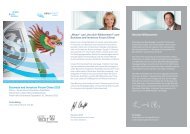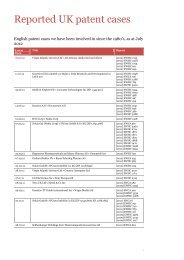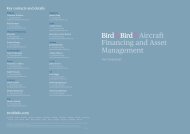Here - Bird & Bird
Here - Bird & Bird
Here - Bird & Bird
You also want an ePaper? Increase the reach of your titles
YUMPU automatically turns print PDFs into web optimized ePapers that Google loves.
552 European Intellectual Property Review<br />
show harm (detriment to distinctive character or repute).<br />
The L’Oréal v Bellure decision by the CJEU thus focuses<br />
on the benefit gained by the defendant rather than on any<br />
direct harm caused to the trade mark owner.<br />
In Jacob L.J.’s view the pendulum has swung too far<br />
towards the interests of the trade mark owner, away from<br />
what is required for the protection of the consumer (since<br />
he is not deceived or confused) and in doing so fails to<br />
protect the consumer’s interest in free competition.<br />
Where the line should be drawn has been much<br />
debated 8 and remains controversial. As Jacob L.J. pointed<br />
out the famous brand has lost no sales from poor<br />
consumers of “smell-alikes” who cannot afford the real<br />
thing which is “beyond their wildest dreams”. In the<br />
particular fact pattern of this case it is also hard to see<br />
how the defendants could have got their “smell-alike”<br />
message across without referring to the famous brands.<br />
If a trader may refer to a famous trade mark in order to<br />
describe spare parts that are suitable for use with products<br />
sold under that famous mark, why was the use by the<br />
smell-alike defendants not also legitimate descriptive<br />
use? The CJEU’s answer is that the use is not “for purely<br />
descriptive purposes”: its use may affect the<br />
communication, advertising and investment functions of<br />
the mark, concepts Jacob L.J. considered to be<br />
conceptually “vague and ill-defined”.<br />
Concern has also been expressed by the European<br />
Commission about the vagueness of the scope and<br />
applicability of the “other functions” of trade marks (other<br />
that is than the essential one of guaranteeing origin). The<br />
written observations of the Commission in the reference<br />
to the CFEU in Interflora v Marks & Spencer, which are<br />
not publicly available but were referred to in the judgment<br />
of Arnold J. of the English High Court in that case on<br />
April 29, 2010, 9 also expressed concern that the existing<br />
jurisprudence of the CJEU including specifically L’Oréal<br />
v Bellure “might not have defined the precise scope of<br />
the exclusive rights of trade mark proprietors with the<br />
required degree of clarity” and suggested that the CFEU<br />
should take the opportunity presented by the reference to<br />
clarify these issues, including reconsidering its judgment<br />
in L’Oréal v Bellure.<br />
In the meantime the English courts have applied or<br />
considered the CJEU guidelines in L’Oréal v Bellure in<br />
the following cases.<br />
The requirement of intention to take an<br />
advantage:<br />
Whirlpool Corp v Kenwood Ltd<br />
In a case involving shape marks for kitchen mixers, the<br />
English Court of Appeal in Whirlpool Corp v Kenwood<br />
Ltd 10 found that there was no unfair advantage. Whirlpool<br />
had failed to prove that consumers were misled by the<br />
appearance of Kenwood’s kMix product into believing<br />
that it was Whirlpool’s KitchenAid Artisan mixer and,<br />
since there was no likelihood of confusion, it relied on<br />
the extended form of protection under art.9(1)(c).<br />
Although the kMix would remind people of the Artisan,<br />
so that the necessary “link” existed, Whirlpool failed to<br />
draw an analogy with the facts of the L’Oréal v Bellure<br />
case. Kenwood had its own existing reputation and did<br />
not need to ride on Whirlpool’s coat-tails. There was also<br />
no evidence of intent to do so. Even if a commercial<br />
advantage had been obtained as a result of the perceived<br />
similarity between the shapes of the mixer, there was no<br />
evidence that this was unfair. Although it might be<br />
possible for something other than intention to turn an<br />
advantage into an unfair one, no other factor had been<br />
identified.<br />
Daimler AG v Sany Group Co Ltd 11<br />
In this case Daimler claimed inter alia that Sany’s logo<br />
used on construction machinery would call to mind the<br />
Mercedes star and thereby incite consumer interest in<br />
Sany’s goods by imbuing them with allure and prestige.<br />
As a result Daimler claimed that Sany had obtained an<br />
unfair advantage under art.5(2). The trial judge failed to<br />
find the necessary link: in her view the Sany mark would<br />
not call to mind the Mercedes star, but she also held that,<br />
if she had found such a link, there was no evidence of<br />
any “leg up” being achieved as a result of any similarity<br />
between the marks. Crucially, given that Sany’s logo had<br />
been innocently adopted and promoted as its house mark<br />
in China many years previously, there was no evidence<br />
of intent. This fact scenario contrasts with that in the next<br />
case considered below.<br />
Specsavers v Asda Stores 12<br />
In this case the English High Court held that the use by<br />
Asda Stores of the strapline “Be a real spec saver at Asda”<br />
infringed Specsavers’ Community trade marks for the<br />
word mark “SPECSAVERS” under art.9(1)(c) of the<br />
Regulation on the basis of an intention to take advantage<br />
of the mark. 13<br />
8<br />
C. Morcom QC, “L’Oréal v Bellure—Who Has Won?” [2009] E.I.P.R. 627; C. Morcom QC, “L’Oréal v Bellure—The Court of Appeal Reluctantly Applies the ECJ ruling:<br />
L’Oréal SA v Bellure NV” [2010] E.I.P.R. 530; D. Meale and J. Smith, “Enforcing a trade mark when nobody’s confused: where the law stands after L’Oréal and Intel”<br />
(2010) 5(2) Journal of Intellectual Property Law & Practice 96; M. Björkenfeldt, “The genie is out of the bottle; the ECJ’s decision in L’Oréal v Bellure” (2010) 5(2)<br />
Journal of Intellectual Property Law & Practice 105.<br />
9<br />
Interflora v Marks & Spencer [2010] EWHC 925 (Ch).<br />
10<br />
Whirlpool [2010] R.P.C. 2.<br />
11<br />
Daimler v Sany [2009] EWHC 2581 (Ch). The author’s firm represented Sany Group Co in this matter.<br />
12<br />
Specsavers International Healthcare Ltd v Asda Stores Ltd [2010] EWHC 2035 (Ch); [2011] F.S.R. 1.<br />
13<br />
Specsavers failed to establish trade mark infringement of their logo marks featuring two overlapping ovals (with and without the word “Specsavers”) under art.9(1)(b)<br />
which requires a likelihood of confusion or a likelihood of association, arising from Asda Stores’ use of a logo in the form of two non-overlapping ovals bearing the words<br />
“ASDA Opticians”. Specsavers’ claim in passing off also failed.<br />
[2011] E.I.P.R., Issue 9 © 2011 Thomson Reuters (Professional) UK Limited and Contributors








